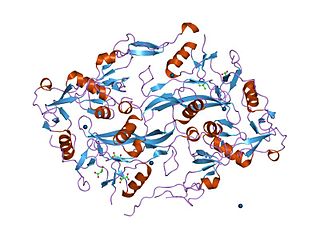Related Research Articles
In biology and biochemistry, protease inhibitors, or antiproteases, are molecules that inhibit the function of proteases. Many naturally occurring protease inhibitors are proteins.

Serpins are a superfamily of proteins with similar structures that were first identified for their protease inhibition activity and are found in all kingdoms of life. The acronym serpin was originally coined because the first serpins to be identified act on chymotrypsin-like serine proteases. They are notable for their unusual mechanism of action, in which they irreversibly inhibit their target protease by undergoing a large conformational change to disrupt the target's active site. This contrasts with the more common competitive mechanism for protease inhibitors that bind to and block access to the protease active site.

Proteinase 3, also known as PRTN3, is an enzyme that in humans is encoded by the PRTN3 gene.
Microbial collagenase is an enzyme. This enzyme catalyses the following chemical reaction

Cathepsin G is a protein that in humans is encoded by the CTSG gene. It is one of the three serine proteases of the chymotrypsin family that are stored in the azurophil granules, and also a member of the peptidase S1 protein family. Cathepsin G plays an important role in eliminating intracellular pathogens and breaking down tissues at inflammatory sites, as well as in anti-inflammatory response.

Thermolysin is a thermostable neutral metalloproteinase enzyme produced by the Gram-positive bacteria Bacillus thermoproteolyticus. It requires one zinc ion for enzyme activity and four calcium ions for structural stability. Thermolysin specifically catalyzes the hydrolysis of peptide bonds containing hydrophobic amino acids. However thermolysin is also widely used for peptide bond formation through the reverse reaction of hydrolysis. Thermolysin is the most stable member of a family of metalloproteinases produced by various Bacillus species. These enzymes are also termed 'neutral' proteinases or thermolysin -like proteinases (TLPs).

The Kazal domain is an evolutionary conserved protein domain usually indicative of serine protease inhibitors. However, kazal-like domains are also seen in the extracellular part of agrins, which are not known to be protease inhibitors.
Metridin is an enzyme. This enzyme catalyses the following chemical reaction
Alpha-lytic endopeptidase or Alpha-lytic protease is an enzyme isolated from the myxobacterium Lysobacter enzymogenes. This enzyme is a serine protease that catalyses the breakage of peptide bonds using a hydrolysis chemical reaction. Alpha-lytic protease was named based on the observed cleavage specificity for the α position of the tetrapeptide component in gram-positive bacterial cell walls (alanine). Alpha-lytic protease is also capable of digesting elastin and other proteins.
Brachyurin is an enzyme. This enzyme catalyses the Hydrolysis of proteins, with broad specificity for peptide bonds. Native collagen is cleaved about 75% of the length of the molecule from the N-terminus.
Lysyl endopeptidase is an enzyme. This enzyme catalyses the following chemical reaction
Streptogrisin A is an enzyme. This enzyme catalyses the following chemical reaction
Penicillopepsin is an enzyme. This enzyme catalyses the following chemical reaction
Endothiapepsin is an enzyme. This enzyme catalyses the following chemical reaction
Serralysin is an enzyme. This enzyme catalyses the following chemical reaction
Bacillolysin is an enzyme. This enzyme catalyses the following chemical reaction
Coccolysin is an enzyme. This enzyme catalyses the following chemical reaction
Peptidyl-Asp metalloendopeptidase is an enzyme. This enzyme catalyses the following chemical reaction
Atrolysin C is an enzyme. This enzyme catalyses the following chemical reaction
Edith Wilson Miles is a biochemist known for her work on the structure and function of enzymes, especially her work on tryptophan synthase.
References
- ↑ Whitaker DR, Roy C, Tsai CS, Jurásek L (December 1965). "Lytic enzymes of Sorangium sp. A comparison of the proteolytic properties of the alpha- and beta-lytic proteases". Canadian Journal of Biochemistry. 43 (12): 1961–70. doi:10.1139/o65-219. PMID 5880182.
- ↑ Whitaker DR, Roy C (June 1967). "Concerning the nature of the alpha- and beta-lytic proteases of Sorangium sp". Canadian Journal of Biochemistry. 45 (6): 911–6. doi:10.1139/o67-101. PMID 6034704.
- ↑ Li SL, Norioka S, Sakiyama F (November 1990). "Molecular cloning and nucleotide sequence of the beta-lytic protease gene from Achromobacter lyticus". Journal of Bacteriology. 172 (11): 6506–11. doi:10.1128/jb.172.11.6506-6511.1990. PMC 526839 . PMID 2228973.